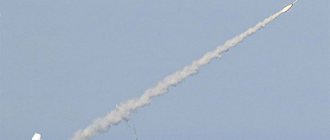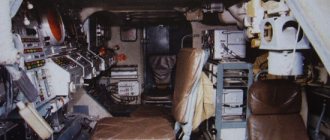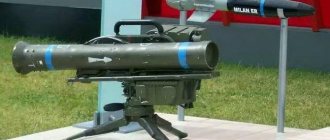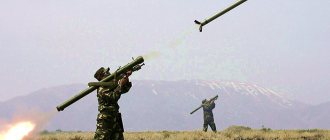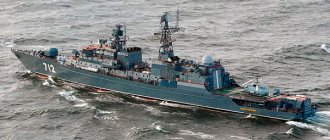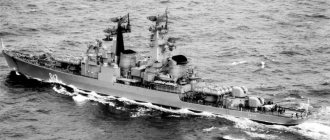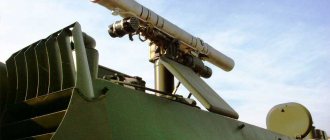Osa-AKM air defense system - video
technical means:
— transport-loading machine 9T217BM2; — maintenance vehicle 9V210M3; — adjustment machine 9V914; — automated control and testing station 9B242-1; — group spare parts kit machine 9FE72M3; — set of ground equipment 9F16M2.
The combat assets of the complex are located on a single base - a floating wheeled self-propelled chassis with high cross-country ability - a combat vehicle (BM). The combat vehicle is completely autonomous, has mobility that is not inferior to accompanying troops, and detects targets while moving. A short stop is required to hit the target.
The BM includes:
— target acquisition radar (TDS) with a ground-based radar interrogator; — target tracking radar (TSS); — two-channel missile sighting radar (SVR); — two-channel station for transmitting commands to missiles; — calculating and solving device (CSD); — television-optical viewfinder (TOV); — primary power supply system; — radio communication system.
The missile of the complex is made according to the “canard” aerodynamic design. Storage, transportation and launch of the rocket are provided by a transport and launch container. A solid-fuel dual-mode engine provides the missile with the required power output necessary for targeting high-speed and maneuvering targets.
The missile's combat equipment is adapted to the specific conditions of the encounter. The warhead is a high-explosive fragmentation type. The most critical targets can be fired at by a burst of two missiles. Transported by all modes of transport, including air. There is a naval modification of the Osa-MA2 complex, which provides air defense for small displacement ships.
Currently, serial production of the complex has been discontinued, however, a large number of Osa-AKM air defense systems continue to be successfully operated in the Russian Army and in the armies of more than 25 countries. Industrial enterprises provide a full range of services to ensure the combat readiness of complexes and offer modernization projects that significantly expand their combat capabilities. Based on elements of the Osa-AKM air defense system, the Saman target complex was developed, intended for testing air defense systems and providing training and increasing the combat readiness of combat crews. The Osa air defense missile system with a special modification is used as a target.
Combat use
- At short range, the complex's radar provided a high signal-to-noise ratio even in conditions of interference, and if this was not possible, it remained possible to work using an optical sight, therefore, when using the Syrian Osa air defense systems in combat operations in southern Lebanon in the early 1980s, Israeli The Air Force was forced to use a massive launch of unmanned aerial vehicles as decoys, followed by an attack by strike aircraft on the positions of the air defense systems that had expended their ammunition. In this way, 3 complexes were destroyed, and the 4th Osa air defense system was shot down by one Israeli RF-4E reconnaissance aircraft; the number of UAVs destroyed was not specified.
- On October 12, 1981, Polisario fighters, using the Osa air defense system, shot down a Moroccan air command post C-130H Hercules, killing the entire crew. The next day, with the help of the Wasp, a Mirage F.1 fighter flying at maximum speed was shot down.
- During military operations in Angola in 1987-1988, the Osa air defense system shot down one Atlas AM.3C Bosbok aircraft, two IAI Scout UAVs and one Kentron Seeker.
- Before the start of Operation Desert Storm, a special US unit using helicopters entered Kuwaiti territory, captured and took away the Osa air defense system with all the technical documentation, and at the same time captured the combat crew consisting of Iraqi military personnel.
- During the fighting in Kuwait, the Iraqi Osa air defense system shot down several Tomahawk cruise missiles.
- The complex was used during the armed conflict in South Ossetia in August 2008 by the Russian and Georgian sides. According to some reports, the Russian Tu-22M3 was shot down by the modernized Osa-AK/AKM complex.
- 9K33M2
was also supplied to Iraq in 1984-1984. and participated in the Iran-Iraq conflict; 2 divisions of 3 batteries each were supplied. - During the Syrian Civil War:
- fighters of the National Coalition of Syrian Revolutionary and Opposition Forces shot down two Mi-8/Mi-17 Syrian Air Force helicopters from a captured complex
- On April 14, 2022, Syrian air defenses used Osa missile launchers to counter a missile attack by the United States, Britain, and France in 2018. According to the Russian Ministry of Defense, a total of 103 cruise missiles were used, of which 71 cruise missiles were successfully intercepted by Syrian air defense systems. S-125, S-200, Buk, Kvadrat and Osa air defense systems were used to repulse the missile attack. According to official data from the US Department of Defense, none of the attacking missiles were hit, and most of the anti-aircraft missile launches were carried out after the cruise missiles reached their target. In total, the Osa air defense system fired 11 missiles and hit 5 targets.
Modifications of the OSA-AKM air defense system
M-4 "Osa-M"
Marine version of the Osa complex (according to NATO classification SA-N-4)
9K33M2 "Osa-AK"
Modernized complex 9K33M2. Adopted into service in 1975.
Main differences from the basic version:
1. The target engagement zone has been expanded in terms of range, height and parameters. 2. The structure of the PSA has been changed, the ability to target missiles at a target moving at a speed of up to 500 m/s and maneuvering with an overload of up to 8 units has been added. 3. Has the ability to fire and hit targets on catch-up courses at speeds of up to 300 m/s. 4. Increased protection from the effects of electronic interference, improved conditions for automatic target tracking in passive interference. 5. A new element base is used, the overall reliability of the BM operation is increased. 6. The SAM radio fuse has been improved. The new fuse reduces the lower limit of the response zone to 27 meters. 7. The missile defense system is located in the TPK. The warranty period for the use of missiles has been increased to 5 years and radiation resistance has been increased. 8. Transportation of eight missiles and loading of the combat vehicle is ensured.
9K33M3 "Osa-AKM"
Further modernization of the complex. This modification can effectively combat airplanes and helicopters when covering troops in all types of combat operations and in conditions of active electronic countermeasures.
Work to improve the Osa BM and its missiles began in November 1975 under the code name “Mara”. The PSI modernized complex passed in 1977, and state tests were completed in December 1979. In 1980, the air defense system was put into service under the designation Osa-AKM.
The main changes made to the Osa-AKM air defense system:
1. The affected area has been expanded. 2. The resolution of the all-round viewing indicator of the SOC has been improved in azimuth and range. 3. The probability of the radio fuse being triggered by the ground has been reduced and the accuracy of missile guidance has been increased due to the improved PSA. 4. The ability to fire at targets moving at speeds of up to 500 m/s and maneuvering with an overload of up to 8 units, as well as the ability to fire at targets flying at a speed of 300 m/s in pursuit. 5. The density of the fragment flow has been increased. Due to the forced submission of a radio command to detonate the warhead, the ability to correct the area of operation of the radio fuse has been improved. 6. The reliability of the BM operation has been increased due to the transfer to a new element base. Improved overall noise immunity. 7. The radio fuse has been improved.
How Wasp was created
In the 50s of the last century, the tactics of air warfare changed dramatically; guided missiles replaced artillery guns.
Guidance was carried out according to information from the radar. This forced pilots to seek salvation at high altitudes or, on the contrary, to hug the ground and fly in the radar dead zone. The issue of protecting motorized rifle divisions from air attacks by low-level aircraft arose with all urgency.
To correct this situation, the USSR Council of Ministers issued a resolution with the task of developing a modern air defense system as soon as possible.
The project was tentatively called “Ellipsoid”.
It instructed the complex:
- the complex must be placed on one chassis;
- The air defense missile systems had to operate not only in a combat position, but also while moving;
- launchers must be capable of firing during short stops;
- the total mass of the rocket should not exceed 65 kg, this was necessary for quick reloading of the launcher by crew forces.
The oldest research institute in the country, NII-20 GKRE, was assigned to develop new anti-aircraft weapons. M. M. Kosichkin, a pioneer in the field of research into small-sized artillery radar in mobile combat, was appointed chief designer.
The means of destruction were created by the Tushinsky Machine-Building Plant, then headed by A.V. Potopalov, a man with experience (at one time he was involved in the creation of the 10X projectile aircraft).
The rocket launcher was commissioned to be designed by the State Design Bureau of Compressor Engineering, now JSC NPP Start named after A.I. Yaskin.
It is very difficult to fulfill such an ambitious plan. Suffice it to say that the Americans did not succeed in a similar project at about the same time, and they closed it. The English Sea Cat with the Tiger Cat missile was inferior to our complex in all respects.
In 1962, developers were still carrying out experiments in laboratories. For a long time, reliable rocket fuel and electronic control devices were not available.
Dissatisfaction with the slow pace of creation of the Wasp resulted in new appointments. The creation of the 9MZZ rocket was entrusted to OKB-2 GKAT, headed by P. D. Grushin. This talented man led the creation of the 1D missile for the S-75 air defense system, which shot down the American U-2 spy plane piloted by F. G. Powers.
The readiness date was moved to the second quarter of 1965 with adjustments to the requirements for the rocket:
| Rocket mass | Allowed to increase the weight to 110...115 kg |
| Object available for locator detection | Similar MIG - 19 |
| Target speed | Ability to shoot down targets at speeds up to 500 m/s |
| Flight altitude | Ability to shoot down targets at altitudes from 50...100m to 5 km at supersonic speeds |
| Ability to shoot down targets at altitudes up to 6...7 km at subsonic speeds | |
| Damage range | 8…10 km at supersonic speeds |
| up to 10…13 km at subsonic speeds |
Missile testing began as planned, and by 1967 it was decided to present the entire complex for testing. But the State Commission, headed by T. A. Mikitenko, discovered discrepancies in the capabilities of the product with the planned target. Flaws:
- Low efficiency and reliability.
- Too long preparation for shooting.
- Insufficient target destruction altitude.
- Burnout of the nozzle block during startup.
- Inadmissible pointing errors.
- Impossibility of firing in some positions of the launcher.
- Shadowing of the viewing area by the launcher from the front.
The partial fault of the customer, who missed such shortcomings even when creating the drawings, did not atone for the fault of the designers.
Organizational conclusions followed. M. M. Kosichkin was replaced by the director of NIEMI (Scientific Research Electromechanical Institute, former NII-20 GKRE. V. P. Efremov (03/22/1926 - 09/16/2006).
Previously, the Krug air defense system was created under his leadership. The deputy was identified as I.M. Drize (03/20/1927 – 11/3/2016), who had already worked with Efremov on “The Circle”. At the same time, the start of comprehensive testing of the Wasp was postponed to the spring of 1970.
In parallel with the creation of the land version, the naval version of the Wasp was being developed.
The creation of chassis 937, later renamed 5937 “Osnova”, was entrusted to the Bryansk Automobile Plant of the Ministry of Automotive Industry with the requirement to make it wheeled and floating.
Having successfully passed the State Commission exam, it was accepted into service on October 4, 1971, and from that moment the Osa air defense system began to enter the Soviet Army. For the needs of the Navy, a version of the Osa-M air defense system was produced. According to NATO classification, this complex is listed as SA-8 “Gecko.
Tactical and technical characteristics of the OSA-AKM air defense system
— Developer: Scientific Research Electromechanical Institute — Years of production: 9K33 from 1970 to 1975. 9K33M2 from 1975 to 1980. 9K33M3 from 1980 to 1988 — Years of operation: from 1971 — Number of produced, pcs.: more than 1200
— Crew, people: 5
Weight of the OSA-AKM air defense system
— Combat weight, t: 18
Overall dimensions of the OSA-AKM air defense system
— Body length, mm: 9140 — Width, mm: 2750 — Height, mm: 4200 (with radar lowered)
Firing range of the OSA-AKM air defense system
— Target detection range, (standard TA aircraft), km: 45 — Boundaries of the affected area: by range, km: 1.5-10 — Boundaries of the affected area: by course parameter, m: up to 6000 — Speed of targets hit, m/s : 10-500 — Target maneuver, units: up to 8 — Reaction time, s: 18-26 — Transfer time from traveling to combat position, min: up to 4 — Launcher reloading time, min: 5 — Number of missiles per launcher, pcs .: 6 — Probability of defeat: typical non-maneuvering target / helicopters: 0.4-0.96 / 0.24-0.76 — Other weapons: 4 x 9M33 missiles (6 missiles on modifications)
OSA-AKM air defense missile system engine
— Engine type: 5D20B-300B — Engine power, l. pp.: 300
Speed of the OSA-AKM air defense system
— Speed on the highway, km/h: 70 — Speed on rough terrain, km/h: 35 off-road, 7..10 afloat
— Cruising range on the highway, km: 500 — Wheel arrangement: 6x6 — Suspension type: individual, torsion bar with wishbones — Fording capacity, m: floating
Operators
Anti-aircraft missile 9M33 in the Patriot park.
- Russia Russia: Russian Ground Forces - 400 9K33M3 as of 2016
- Russian Marine Corps - 20 9K33 as of 2016
- Algerian ground forces - about 48 9K33M as of 2016;
- Indian ground forces - more than 50 9K33M2 as of 2016;
Former operators
- USSR USSR - passed to the states formed after the collapse.
- Libya Libya - a number of 9K33 as of 2012.
Photo of OSA-AKM air defense system
Similar
ZSU-23-4 Shilka. Rate of fire. Armament. Dimensions. Weight
S-75 air defense systems Dvina, Desna, Volkhov. Compound. Rockets. Damage range
ZRPK Pantsir-S1. Armament. Price. Detection range
S-350E Vityaz air defense system. Compound. Rockets. Damage range
OSA-AKM air defense missile system. Firing range. Rockets. Compound. Dimensions. Weight
ZSU 2S6M Tunguska-M. Damage range. Rockets. Compound. Dimensions
ZRK 2K12 KUB. Damage range. Rocket speed. Principle of operation
SAM Buk-M1-2. Detection and destruction range. Rockets. Possibilities
SAM S-200 Angara, Vega, Dubna. Damage range. Compound. Principle of operation
MANPADS 9K310 Igla-1. Damage range. Weight. Possibilities
SAM 9K331 Tor-M1. Damage range. Rocket. Principle of operation
MANPADS Verba. Damage range. Rocket. Composition of the complex
SAM S-125 Neva (Pechora) Range and height of destruction. Rockets
S-400 Triumph air defense system. Damage range. Rockets. How does it work
SAM 9K35 Strela-10. Damage range. Modifications. Rockets
SAM S-300PMU2 Favorite. Damage range. Compound. Rockets
SAM S-25 Berkut. Range and altitude of damage. Rockets
SAM Sosna. Armament. Damage range. Rockets. Compound
American Patriot air defense system. Damage range. Compound. Rockets
Naval air defense missile system Dagger. Damage range. Compound. Rockets. On what ships is it installed?
ZRK 2K11 Circle. Damage range. Modifications. Compound
Anti-aircraft gun ZSU-57-2. Armament. Dimensions. Booking
KTPU "Gibka" (3M-47) Damage range. Rockets. Principle of operation
"Osa-M" - shipborne anti-aircraft missile system
MANPADS 9K34 "Strela-3"
FIM-92A Stinger - American MANPADS
S-300V (9K81) - anti-aircraft missile system
9S482M7 (PU-12M7) - battery-operated mobile control station
SAM "Avenger" - American mobile anti-aircraft missile system
MANPADS 9K32 "Strela-2"
SAM M-1 "Volna" (4K90) - ship-based anti-aircraft missile system
MD-PS - anti-aircraft missile system
ZSU-37 - self-propelled anti-aircraft gun
